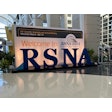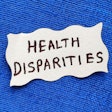A century ago, radiation was considered to be so healing that entrepreneurs canvassed natural hot springs with Geiger counters to find radioactivity, then bottled the water and sold it as a health drink.
It's true that radiation can be healing, and it certainly can be diagnostic. But only in particular doses, and in a hospital radiology department it's essential to protect not only patients but also staff from overexposure. Emily Blomenberg, director of imaging and oncology services at Morristown-Hamblen HealthCare System in Morristown, TN, offered hospital administrators a primer on an effective radiation safety program at the 2007 American Healthcare Radiology Administrators (AHRA) meeting held in Orlando, FL.
Why radiation safety?
Remember the "Radium Girls" of the 1920s? Employed by U.S. Radium Corporation of New Jersey, these women worked at long factory tables, hand-painting watch and instrument faces with luminescent radium powder paint. Many of them eventually suffered anemia, bone fractures, and necrosis of the jaw (from shaping the paintbrushes into a tip with their mouths), as well as osteosarcomas in their fingers.
Thankfully, the occupational dangers today due to radiation exposure are nothing like what these women experienced. But radiation damage is a reality, and can be categorized in two ways: Nonstochastic effects -- like skin reddening, hair loss, dry and moist desquamation, and acute radiation syndrome -- which occur at a specific dose level and increase as the dose increases, and stochastic effects -- like cancer, genetic defects, and leukemia -- which can occur at any dose (the severity of the injury isn't dependent on the received dose). Protecting hospital staff from these effects is crucial.
Radiation safety fundamentals
The elements of a comprehensive radiation safety program include an active radiation safety committee (RSC) and radiation safety officer (RSO), appropriately used personnel radiation exposure monitoring devices, and a thorough ALARA (As Low As Reasonably Achievable) protocol, Blomenberg said.
Not all states have an agreement with the U.S. Nuclear Regulatory Commission (NRC) to run their own radiation safety programs; those states that do not have this agreement are subject to the NRC. When putting together a program, it's crucial to determine whether the state in which the facility is located is an agreement state or not, and what kind of oversight the facility can expect.
The RSC is responsible for the oversight of the radiation safety program and for ensuring that radioactive materials and all sources of ionizing radiation are used safely throughout the hospital. The committee should meet at least four times per year, Blomenberg said, and more if the RSO requests it.
"People like to see a proactive radiation safety committee, rather than an obligatory one," she said.
A hospital's RSO is often a radiologist, but can also be a physicist or a nuclear medicine technologist, depending on available staff. The RSO is responsible for reviewing regular exposure reports generated by contracted radiation safety firms; at least once a year, this report is posted in a prominent place, and lists exposure levels for all employees who use radiation areas. (Facilities can request report copies that do not include employees' Social Security numbers for public posting.) Posting the report puts the responsibility for tracking radiation exposure back into the hands of employees, Blomenberg said.
"The RSO is the radiation czar of the hospital," she said. "He or she is responsible for the implementation of the radiation safety program, making sure it runs like it should and making policy recommendations if necessary. But it's really up to each individual staff person to track their exposure."
The annual maximum permissible dose equivalents for occupationally exposed workers (per the NRC) in millirems (mrem) are:
- Deep, whole body: 5,000 mrem
- Extremity, hands/forearm: 50,000 mrem
- Lens of the eye: 15,000 mrem
- Shallow, skin whole body: 50,000 mrem
The National Council on Radiation Protection (NCRP) mandates radiation exposure monitoring for:
- Any worker likely to receive a whole-body dose in excess of 25 mR in a given week
- A person who could receive 10% of the maximum annual dose limit
- Any person who routinely enters a designated "High Radiation Area"
- Anyone who operates fluoroscopic equipment or mobile x-ray equipmentM
- Anyone who services x-ray equipment
Radiation monitor badges track staff exposure levels -- but only if they're worn at all, worn correctly, turned in promptly for reporting, and stored in a radiation safe area. Blomenberg advises hospital RSCs to offer periodic training for radiation personnel on where to wear badges and how to manage them.
Collar badges need to be worn on the collar outside the lead apron; waist badges at the waist inside the lead apron; and extremity badges on the lower leg level outside the lead apron. Remind staff not to wear badges when receiving x-rays for personal health care, when away from the workplace, or under the apron (unless the person is using more than one dosimeter), or place it next to radiation areas.
The Joint Commission (formerly known as on Accreditation of Healthcare Organizations or JCAHO) has recently mandated that workers need to report radiation exposure that occurred elsewhere than their primary facility so that an accurate record of the work's total exposure can be collected, Blomenberg noted.
Assuring ALARA
The NRC's guidelines for the maximum permissible dose (MPD) for workers that are exposed to radiation say that a worker cannot receive more than five rem annually. Pregnant workers may not receive more than 0.5 rem per gestation. The NRC's "ALARA" rule means that all radiation exposures must be kept as low as reasonably achievable; the way to do this is to decrease the time of exposure, increase the distance between the radiation source and the individual, and increase the shielding used during the procedure.
Federal regulations for radiation ALARA limits for nuclear medicine workers are divided into action levels one and two per calendar quarter: Deep, whole body and eyes, 125 mrem (level one) and 375 mrem (level two); hands, 1875 mrem (level one) and 5625 mrem (level two); and shallow, skin, 750 mrem (level one) and 2250 mrem (level two).
At Morristown-Hamblen HealthCare System, Blomenberg has created a system that reminds her to send out ALARA notifications to staff whenever their exposure is approaching dangerous levels so that the person can find ways to decrease their exposure; at other hospitals, this kind of warning communications might come from the RSC instead.
"I send the employee the ALARA notification, they review it and write the reason for the high level -- they left their badge in the room, they forgot to take it off, whatever it is -- and return it to me," Blomenberg said. "That way we have a record of an employee's radiation exposure."
ALARA notifications can communicate two levels of exposures: Level one exposures are 10% of the maximum permissible dose set by the NRC; and level two exposures are 30% of the maximum permissible dose set by the NRC.
If employees balk at adjusting their exposure, it can help to get the RSO involved, Blomenberg said.
"Sometimes it just takes the recommendation of a doctor to help an employee understand that their health is at risk if they don't protect themselves," she said.
By Kate Madden YeeAuntMinnie.com staff writer
August 17, 2007
Related Reading
Strategies for reducing 'dose creep' in digital x-ray, April 11, 2007
Study suggests ways to cut CR radiation, March 5, 2007
Korean rads find no edge for high-res CR in chest exams, January 22, 2007
Study: DR delivers lower radiation dose, November 7, 2006
U.S. hospitals find ways to take the digital x-ray plunge, October 12, 2006
Copyright © 2007 AuntMinnie.com




















